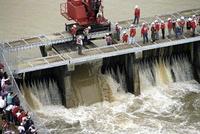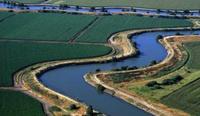-
Historic, desperate measures to control Mississippi River

The historic levels of water swelling the Mississippi River required the Army Corps of Engineers to take historic measures to prevent catastrophic flooding of Baton Rough and News Orleans: first, the Morganza control structure, located 186 miles upriver of New Orleans and completed in 1954 as part of the Army Corps of Engineers’ broad flood-protection upgrades in the wake of the Great Flood of 1927, was opened for only the second time to allow water to flow out of the river and into the Atchafalaya basin, a designated flood relief area; the Corps says that Saturday marked the first time in history that all three floodways built by corps after 1927 flood — the Morganza Floodway, the Bonnet Carre Spillway, and the Birds Point floodway in Missouri — have been in operation at the same time; about 25,000 people and 11,000 structures are in harm’s way, as up to 25 feet of flooding is expected in a 3,000 square-mile area of Louisiana
-
-
New Orleans debates hurricane protection plans

The Army Corps of Engineers is currently deciding how best to implement its $2.9 billion Mississippi River-Gulf Outlet (MR-GO) restoration plan in New Orleans; the plan is part of several projects designed to protect the Louisiana coast line from hurricane storm surges; residents are clashing over the plan and the public hearing period for the plan has been extended; state legislators are currently debating with the corps, as the $2.9 billion project funds do not include the costs for land acquisition, design, and operation and maintenance; the project is expected to take ten years to complete and construction could begin as early as 2012
-
-
Expert urges broad reforms in managing California's water

Most threatening to California’s water situation is the vulnerability of the hub of the state’s fresh water system, the Sacramento-San Joaquin delta, which drains water from the northern Sierra mountains; over the past century, farmers have built a network of more than 1,700 kilometers of levees to protect farmland in the delta from floodwaters; those levees are weak and vulnerable to earthquakes, seasonal floods, and rising waters expected as a result of climate change; the failure of even a fraction of the levees would draw massive amounts of saltwater in from San Francisco Bay, forcing the state to shut off the pumps, cutting off water supplies for many months, and costing the state’s economy billions of dollars
-
-
Danger building up behind aging, vulnerable dams
Of the U.S. 85,000 dams, more than 4,400 are considered susceptible to failure; a 2009 report put the cost of fixing the most critical dams — where failure could cause loss of life — at $16 billion over twelve years, with the total cost of rehabilitating all dams at $51 billion; those figures do not include dams among the approximately 3,000 that are owned by the federal government; the Army Corps of Engineers, for example, says that more than 300 of the roughly 700 dams it is responsible for need safety-related repairs, and estimates the total fix-up bill at about $20 billion
-
-
California Delta plan released, canal recommendation missing
Last week the Delta Stewardship Council released the first draft of its proposed plan to resolve safety concerns over California’s Sacramento-San Joaquin River Delta, one of the state’s most critical pieces of infrastructure; the Delta accounts for 76 percent of the state’s fresh water supply; engineers, residents, and politicians fear that the aging levees along the Delta will break in the event of an earthquake; missing from the initial draft is a recommendation for a peripheral canal, a controversial proposal that has sparked fierce debate; more details will be added to the plan in subsequent drafts after public meetings are held to debate its contents; the final draft of the plan is scheduled to be completed and adopted in November 2011
-
-
California dams plagued by seismic concerns
Half of Santa Clara County, California’s reservoirs cannot be filled to their full capacity due to seismic concerns; engineering tests revealed that in the event of a major earthquake the dam could slump sending a deadly tidal wave across densely populated communities; seismic retrofit costs to the county’s dam are estimated at $150 million; with the reduced capacity, the county’s dams must be maintained at 67 percent of its total capacity and cannot store more water in preparation for future droughts; the lost capacity could provide water for 280,000 people for a year
-
-
Securing the California Delta's levees before a major earthquake
In the event of a major earthquake or flood and many levees failing simultaneously in California’s Sacramento-San Joaquin River Delta, as many as 515,000 residents and 520,000 acres of land would be in immediate danger; the long term effects could be even more widespread, as nearly 28 million residents depend on the Delta for water and irrigation; California lawmakers have increasingly turned their attention to securing the Sacramento-San Joaquin River Delta’s levees, but experts say that only little progress has been made
-
-
Louisiana worried about Corps' levee armoring plans
Louisiana says the Corps of Engineers is $1 billion short for completing levee construction around New Orleans, while the Corps says it has enough money; the disagreement over the cost of completing levee construction centers on a long-simmering argument over the last construction task scheduled for earthen levees throughout the system: deciding what type of armoring will keep the levees from washing away if they are overtopped
-
-
China's Three Gorges Dam's showing cracks
The Three Gorges Dam is China’s largest construction project since the Great Wall; the dam was hailed as an engineering feat that could withstand the worst flood in 100 years, but this year’s torrential rains have severely tested its capacity to control the surging Yangtze
-
-
Rubber dam at Tempe Town Lake bursts, emptying lake overnight
An inflatable rubber dam (called “bladder”) on Tempe’s Town Lake exploded, sending a wall of water into the Salt River bed; at least three-quarters of the about one billion gallons of water had drained overnight; those parts of the rubber dam which are wet have held up, but a plan to keep those parts of the dam which are above water failed, exposing the rubber to scorching sun that has damaged the material
-
-
Berkeley quake demonstration shows bridge safety ideas
Researchers demonstrate new bridge design that can withstand powerful earthquakes; the design concept relies on building segmented bridges with seismic isolators between the segments; the design would be particularly useful for long stretches of elevated freeways and high-speed rail lines that often run on elevated tracks
-
-
Self-healing concrete developed
University of Rhode Island researchers develop a new type of self-healing concrete that promises to be commercially viable and have added environmental benefits; a microencapsulated sodium-silicate healing agent is embedded directly into a concrete matrix; when tiny stress cracks begin to form in the concrete, the capsules rupture and release the healing agent into the adjacent areas
-
-
How to protect Times Square -- and other highly traveled areas
New Yorkers were lucky that a T-shirt vendor notices the suspicious SUV left by Faisal Shazad in Times Square, but there are ways to improve on luck in trying to secure highly traveled areas; more coordinated CCTV system, blast-mitigation, and more call boxes are a few of the measures
-
-
Remotely controlled robot inspects dangerous structures
A remotely controlled robot uses laser sensors to look inside damaged structures to look for survivors; when inside the structure, the robot takes multiple scans using Light Detection and Ranging (LIDAR) unit that takes up to 500,000 point measurements per second. It also can scan through walls and windows
-
-
New California tremor map shows 50 new faults
California has an estimated 15,000 faults; many of those are short, and experts have found no evidence that they have generated sizable temblors; others, though, can produce major quakes; the state’s geological agency have placed fifty new faults — all of them surface faults that have been discovered over the last two decades — on one map which will help educate the public and aid in planning and quake readiness
-
- All
- Regional
- Water
- Biometrics
- Borders/Immig
- Business
- Cybersecurity
- Detection
- Disasters
- Government
- Infrastructure
- International
- Public health
- Public Safety
- Communication interoperabillity
- Emergency services
- Emergency medical services
- Fire
- First response
- IEDs
- Law Enforcement
- Law Enforcement Technology
- Military technology
- Nonlethal weapons
- Nuclear weapons
- Personal protection equipment
- Police
- Notification /alert systems
- Situational awareness
- Weapons systems
- Sci-Tech
- Sector Reports
- Surveillance
- Transportation
Advertising & Marketing: advertise@newswirepubs.com
Editorial: editor@newswirepubs.com
General: info@newswirepubs.com
2010-2011 © News Wire Publications, LLC News Wire Publications, LLC
220 Old Country Road | Suite 200 | Mineola | New York | 11501
Permissions and Policies
Editorial: editor@newswirepubs.com
General: info@newswirepubs.com
2010-2011 © News Wire Publications, LLC News Wire Publications, LLC
220 Old Country Road | Suite 200 | Mineola | New York | 11501
Permissions and Policies
